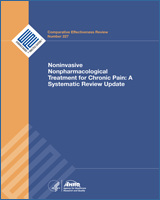From: Results

NCBI Bookshelf. A service of the National Library of Medicine, National Institutes of Health.
| Author, Year, Followup,a Pain Duration, Study Quality | Intervention | Population | Function and Pain Outcomes | Other Outcomes |
|---|---|---|---|---|
Boline, 1995188 1 month Duration of pain: 13.5 years Poor | A. Spinal Manipulative Therapy (n=70): short-lever, low-amplitude, high-velocity thrust techniques on cervical, thoracic or lumbar spinal segments. Moist heat and light massage preceded manipulation; 12, 20 minute sessions (2 per week for 6 weeks) B. Amitriptyline (n=56): dose titration of amitriptyline for 6 weeks. Nighttime, daily doses began at 10mg/day for first week, then increased to 20mg/day in the second, followed by 30mg/day in the third week and after; continued use of OTC medications as-needed. | A vs. B Age: 41 vs. 42 years Female: 54% vs. 70% Race: NR Baseline Daily headache intensity (0-20)b: 5.6 vs. 5.0 Baseline Weekly headache frequency (0-28)c: 12.4 vs. 10.8 | A vs. B 1 month Daily headache intensityb: adjusted means 3.8 vs. 5.2; difference 1.4 (95% CI 0.3, 2.3) Weekly headache frequencyc: adjusted means 7.6 vs. 11.8; difference 4.2 (95% CI 1.9, 6.5) | A vs. B 1 month SF-36 Function Health Status Global Score (% points): adjusted means 78.8 vs. 73.9; difference 4.9 (95% CI 0.4, 9.4) OTC medication usage: adjusted means 1.3 vs. 2.2; difference 0.9 (95% CI 0.3, 1.5) |
Castien, 2011187 4.5 months Duration of pain: 13 years Fair | A. Spinal Manipulation (n=38): combination of 3 approaches at the therapist discretion: mobilizations of the cervical and thoracic spine, craniocervical muscle exercises and posture correction; maximum of 9, 30-minute sessions over 2 months B. Usual Care (n=37): 2-3 general practitioner visits over 2 months | A vs. B Age, years: 40 vs. 40 years Female: 78% vs. 78% Race: NR Mean frequency of headache (days/month): 24 vs. 24 NSAID use: 29% (mean 3 pills/week); Analgesic use: 59% (mean 1.5 pills/week) Baseline HIT-6 (36-78): 62.6 vs. 61.2 Baseline HDI (0-100): 39.6 vs. 44.2 Baseline Pain intensity, NRS (0-10): 6.3 vs. 5.7 | A vs. B 4.5 months Proportion of patients with ≥50% reduction in headache frequency: 81.6% vs. 40.5%; RR 2.01 (95% CI 1.32 to 3.05) HIT-6, mean change from baseline: −10.6 vs. −5.5; difference 5.0 (95% CI −9.02 to −1.16) HDI, mean change from baseline: −20.0 vs. −9.9; difference −10.1 (95% CI −19.5 to −0.64) Headache frequency (days/14 days), mean change from baseline: −9.1 vs. −4.1; difference −4.9 (95% CI −6.95 to −2.98) Pain intensity mean change from baseline: −3.1 vs. −1.7; difference −1.4 (95% CI −2.69 to −0.16) Headache duration (hrs./day), mean change from baseline: −7.0 vs. −3.5; difference −3.5 (95% CI −7.71 to −0.63) | A vs. B 4.5 months Resource use, proportion who used: ≥1 sick leave day: 7.9% vs. 32.4%; RR 0.23 (95% CI 0.07 to 0.79) Any additional healthcare: 13.2% vs. 59.4%; RR 0.22 (95% CI 0.09 to 0.52) Additional physical therapy: 2.6% vs. 40.5%; RR 0.06 (95% CI 0.01 to 0.47) Additional medical specialist care: 2.6% vs. 16.2%; RR 0.16 (95% CI 0.02 to 1.28) Additional “other” healthcare”: 7.8% vs. 2.7%; RR 2.9 (95% CI 0.3 to 26.8) |
Unless otherwise noted, followup time is calculated from the end of the treatment period
Headache intensity was calculated as the total ratings per period and divided by the number of days per period
Headache frequency was calculated by summing all headache ratings 2 and above for the month
From: Results

NCBI Bookshelf. A service of the National Library of Medicine, National Institutes of Health.